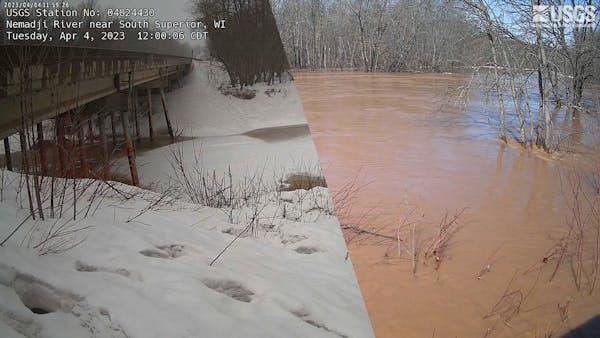Floodwaters across Minnesota are nearing their peak and likely to remain high over the next week or more, said weather experts, who are watching closely as more rain could shift predictions.
Gov. Tim Walz held his second flood briefing of the season Wednesday, where officials cautioned people to stay away from floodwaters and be prepared if they use private wells. They also mapped the continued rise of rivers across the state.
Melting snow and rain is flowing through tributaries. If those smaller waterways are going to flood, it is happening right now, said Dan Hawblitzel, the meteorologist-in-charge for the Twin Cities National Weather Service.
That water is being channeled into major rivers, including the St. Croix, Mississippi, Minnesota and Red River of the North, he said, and more locations along those rivers are expected to see major flooding over the next week.
"Those are the ones that are going to be highly dependent on what we see with this current system [of rain] as well as any potential precipitation coming in the week ahead," Hawblitzel said, adding, "We cannot rule out significant enough rainfall to cause a bump in the rivers primarily along and downstream of the Twin Cities."
Rain is anticipated Wednesday and Thursday and there's chance for more later next week, Hawblitzel said, but after that he anticipates a dry stretch where the rivers should be able to start falling.
Minnesota's snowpack has disappeared everywhere expect along the Red River of the North basin. That river flows from south of Fargo to Lake Winnipeg. There are some pockets of snow that will be channeled into the river, but Hawblitzel said he isn't expecting a quick melt soon.
Across Minnesota, 19 cities, counties and tribal governments had issued local emergency declarations as of Wednesday morning, said Kevin Reed, the interim deputy director of Homeland Security and Emergency Management. That allows the governments to free up resources to take protective measures or provide quick aid if needed, he said.
Those local governments are starting to assess potential damage, Reed said, and on Wednesday afternoon the Walz administration will start discussing recovery needs. They will be talking about where funding might come from and the potential for a state or presidential disaster declaration, he said.
State officials also offered safety warnings Wednesday.
About 20% of Minnesotans get their water from private wells and those users need to protect their drinking water from floodwaters that carry hazardous materials, said Cheryl Petersen-Kroeber, the assistant commissioner of the Minnesota Department of Health.
She said Minnesotans who anticipate flooding should store some water and then turn off their well pumps, or tape plastic over their well if they are short on time. Potentially contaminated wells need to be inspected, disinfected and cleaned, she said.
Walz, meanwhile, reiterated his message that people need to stay away from floodwaters.
"Please, please, please do not drive around barricades," Walz said, noting that the fast-evolving situation could mean a road that was clear could be covered in water within a few hours.
Hope Hicks, ex-Trump adviser, recounts political firestorm in 2016 over 'Access Hollywood' tape

